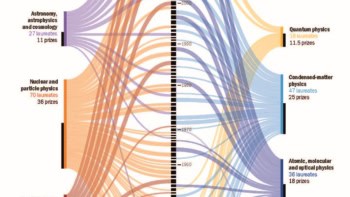By James Dacey
From Darwin and his tree of life to Mendeleev and his conception of a periodic table of elements, images and visual metaphors have played a vital role throughout the history of science. Today, the Royal Society has launched a new online picture library to allow people to browse and search its vast collection of images online for the first time. The collection includes paintings, drawings and prints dating back to when the society was founded in the mid-17th century. Here is a selection of the images connected with physics and physicists.

Orrery demonstrating the transit of Venus
This is a mechanical device known as an orrery, designed to show the relative positions and motions of the planets and moons in the solar system. The British instrument maker Benjamin Cole (1695–1766) made this orrery, which is of particular interest this year because it depicts a transit of Venus – a phenomenon that will occur in June for the last time for more than 100 years.

Eyes and head of a grey drone-fly
Flies can be a bit of a nuisance when buzzing around your head, but when viewed under a microscope, these insects are nothing short of hideous. This sketch of the eyes and head of a grey drone-fly was produced by the natural philosopher Robert Hooke and it appeared in the Royal Society’s 1665 publication Micrographia.

The waterwheel and conduit for Scrooby Mill
The Royal Society’s collection also contains a number of engineering and architectural plans, including this design for the waterwheel and conduit for Scrooby Mill in the English county of Nottinghamshire. It was sketched in 1782 by the British civil engineer John Smeaton.

Engraving of a flying fish
Finally, we have this image of a flying fish, which, according to the Royal Society, holds an unlikely place in the history of modern physics. It is part of a set of engravings from a 1686 book Historia Piscium (a History of Fishes) by John Ray and Francis Willughby, for which the Royal Society held high hopes. But after the society had invested all of its available funds, the book went on to be a flop, meaning there was no money left to publish Newton’s Philosophiæ Naturalis Principia Mathematica (Mathematical Principles of Natural Philosophy), which had been “knocking around the office”.
The story goes that a young Edmund Halley – then clerk at the Royal Society – saw the promise in Newton’s work and managed to raise the funds to publish the Principia, providing much of the money from his own pocket. Newton’s book was finally published in 1687, and went on to revolutionize our understanding of the physical world.



